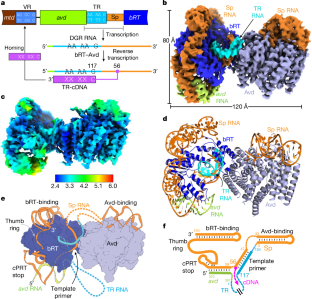2025-01-08 カリフォルニア大学サンディエゴ校(UCSD)
<関連情報>
- https://today.ucsd.edu/story/uncovering-natural-gene-editing-technique
- https://www.nature.com/articles/s41586-024-08405-w
多様性を生み出すレトロエレメントにおける逆転写のRNA制御 RNA control of reverse transcription in a diversity-generating retroelement
Sumit Handa,Tapan Biswas,Jeet Chakraborty,Gourisankar Ghosh,Blair G. Paul & Partho Ghosh
Nature Published:08 January 2025
DOI:https://doi.org/10.1038/s41586-024-08405-w

Abstract
Diversity-generating retroelements (DGRs) create massive protein sequence variation (up to 1030)1 in ecologically diverse microorganisms. A recent survey identified around 31,000 DGRs from more than 1,500 bacterial and archaeal genera, constituting more than 90 environment types2. DGRs are especially enriched in the human gut microbiome2,3 and nano-sized microorganisms that seem to comprise most microbial life and maintain DGRs despite reduced genomes4,5. DGRs are also implicated in the emergence of multicellularity6,7. Variation occurs during reverse transcription of a protein-encoding RNA template coupled to misincorporation at adenosines. In the prototypical Bordetella bacteriophage DGR, the template must be surrounded by upstream and downstream RNA segments for complementary DNA synthesis to be carried out by a complex of the DGR reverse transcriptase bRT and associated protein Avd. The function of the surrounding RNA was unknown. Here we show through cryogenic electron microscopy that this RNA envelops bRT and lies over the barrel-shaped Avd, forming an intimate ribonucleoprotein. An abundance of essential interactions in the ribonucleoprotein precisely position an RNA homoduplex in the bRT active site for initiation of reverse transcription. Our results explain how the surrounding RNA primes complementary DNA synthesis, promotes processivity, terminates polymerization and strictly limits mutagenesis to specific proteins through mechanisms that are probably conserved in DGRs belonging to distant taxa.

00224-3/asset/9bd2e67c-abfd-46a1-9640-974ed303cc2d/main.assets/gr1.jpg)
